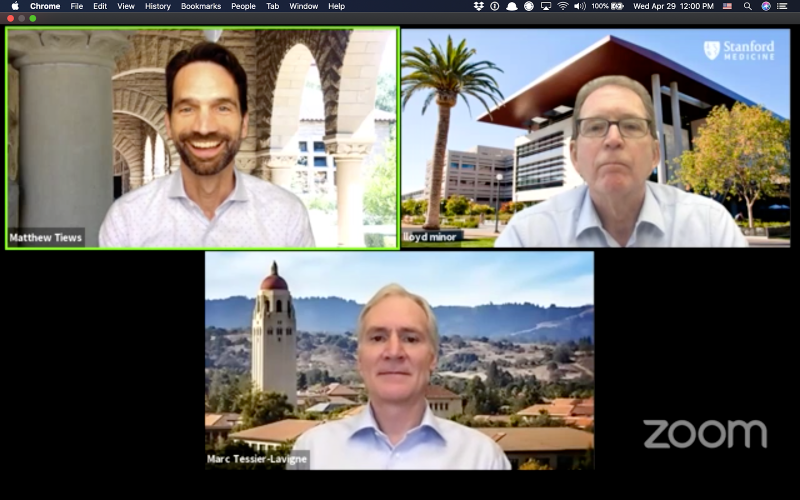President Marc Tessier-Lavigne, Provost Persis Drell and School of Medicine Dean Lloyd Minor answered questions about budget cuts, COVID-19 research and the University’s current standings on options for fall quarter in a Zoom conversation on Wednesday.
Tessier-Lavigne said that the campus activity will resume in a “phased restart,” saying that the communal nature of undergraduate living is an impediment to physical distancing, and that any return of students to campus would need to consider the needs of staff and faculty. A decision will not be made until sometime in June, according to an email from Tessier-Lavigne on Tuesday.
He said factors in decision-making include the availability of means to test, track and treat the disease in the fall, as well as educational considerations.
Drell said there have even been discussions about using tents for instruction in the fall, to “take advantage of the weather” and potentially slow the spread of the disease by being outdoors.
“Absolutely nothing is off the table,” Drell said.
COVID-19 has also created uncertainty surrounding Stanford’s budget. Drell said the University has asked units to begin a worst-case budget scenario planning effort. University units had been told to plan for a 15% reduction in endowment payout and a 10% reduction in allocations from general funds, Drell said at a recent Faculty Senate meeting.
Drell said that Stanford is committed to “continued access for students, including through robust financial aid,” even as the institution stewards its resources for the long term.
When asked if it was possible to address the deficit by decreasing the endowment principal — the core invested portion — Drell responded that “options are open,” but only 20 to 25% of the endowment can be used, without legal restriction, for the University as need may be.
“There is a real caution that needs to be applied in using long-term funds for short-term needs,” she said.
Asked if staff layoffs or furloughs were being planned, Drell said that the situation was still too uncertain to say.
“We know how frustrating it is for all of you, but trust me, it is frustrating for us as well that we do not have clarity on what the financial challenge will be,” Tessier-Lavigne said.
The conversation also featured updates on Stanford Medicine’s COVID-19 research from Minor, who said that a vaccine may realistically be a year to 18 months in the future.
Stanford researchers have been involved in the two clinical trials that are reporting evidence that the drug remdesivir is effective against the virus, according to Minor.
In addition to these clinical trials, the School of Medicine is collaborating with University of California-San Francisco (UCSF) and the Chan-Zuckerburg Biohub to launch a new study on the prevalence of COVID-19 in the Bay Area. A serological study recently conducted by Stanford affiliates on a similar topic has been criticized for potential statistical errors.
Minor said that Stanford Medicine had been scaling up and performing COVID-19 testing in early March, before many healthcare systems in the area, and had tested 9,000 healthcare workers this past week. But he cautioned that commercial labs would have to carry the burden of performing broad testing.
Stanford Hospital has also gradually begun to resume elective healthcare according to state guidelines, as an immense surge in hospitalized COVID-19 patients is no longer likely, according to Minor.
Telehealth has been a silver lining in the crisis, Minor said, as Stanford Hospital now conducts more than 3,000 virtual patient visits a day.
“I’ve never been prouder to be at Stanford than these past two months,” Minor said. “And the way we’ve come together as a community is exemplary, and it’s going to get us through the challenging days ahead.”
The event closed on a hopeful note with calls to stay connected and Tessier-Lavigne recommending playing charades over Zoom.
“As imperfect as Zoom calls are,” he said, “they are a way of maintaining contact.”
Contact Angie Lee at angielee ‘at’ stanford.edu and Omkar Shende at oshende ‘at’ stanford.edu.
